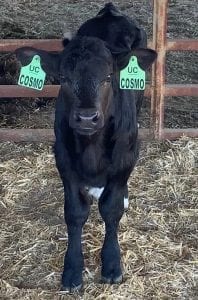Researchers at the University of California Davis have successfully produced a bull calf using the genome-editing technology CRISPR to enable him to sire more male offspring. The CRISPR calf named Cosmo was the culmination of several years of work that was presented at a recent meeting of the American Society of Animal Science. After several unsuccessful attempts, the scientists managed to insert, or knock-in, the SRY gene that determines sex into a bovine embryo.
“We wanted to do a gene knock-in and that’s really hard to do in a developing embryo, so that was one of our holdups. We eventually were able to get the knock-in on chromosome 17 in what’s called a safe harbor position,” said Alison Van Eenennaam, Animal Genomics, and Biotechnology Specialist at UC Davis. “We’ve had some drawbacks, but then finally he arrived in the middle of a global pandemic as fate would have it.”
The specific process that produced Cosmo is the first of its kind as it pertains to genome-editing in cattle. The scientists initially tried to insert the SRY gene directly into the X chromosome to assure all offspring would be male, but the attempts proved to be unsuccessful. Chromosome 17 offered a suitable alternative to get as close to the desired result a possible without creating disruption to other genes.
“This bull is predicted to produce 75 percent male offspring,” Van Eenennaam explained. “Of course, we have to wait for him to mature, and then we can test whether or not the inheritance of this knock-in will actually result in a male appearance in animals.”
Cosmo the CRISPR calf and his ability to generate more male offspring presents significant value potential for the livestock industry. While Cosmo is a research animal and neither he nor his offspring will be entering the food supply, the research process could become valuable for beef producers in the future. Males use feed more efficiently to accumulate mass compared to females, making them more valuable. While the process that produced Cosmo shows promise, it remains to be seen how it would be implemented into a commercial setting. “Because we’re using genome editing it basically results in a new animal drug and that has quite an extensive regulatory process associated with it in the United States, but not necessarily in other countries,” Van Eenennaam noted.











